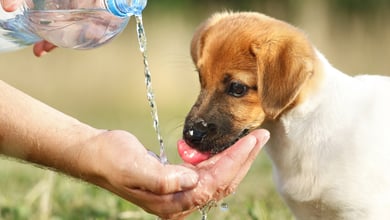11 Ways to Keep Dogs Cool in the Summer

Summer is here, and temperatures are rising! While it's a great time for outdoor fun with your furry friend, it's important to be aware of the dangers of hot weather for dogs.
Dogs don't sweat like humans, so they rely on panting and heat release from their paw pads to cool down. This makes them more susceptible to heatstroke and hyperthermia, both serious conditions that require immediate veterinary attention.
Key Takeaways
-
Keep a close eye on your dog on hotter days
-
Temperatures in the 70s and above pose health risks and dangers for your dog
-
Age, breed, and health status may have an individual impact on your dog's ability to cool down on a hot day
-
Staying home with an ice treat or kiddie pool may be the best option when temperatures get too hot outside
Breed, Age, and Other Risk Factors
Certain breeds are at a higher risk of heat-related health issues. Brachycephalic breeds like pugs, bulldogs, and Shih Tzus have shorter snouts that make it harder to pant, putting them at a greater risk of heatstroke.
Older dogs, overweight dogs, black dogs, and dogs with health conditions may struggle to cool down and require more frequent breaks in the shade with access to water. Dogs with thin fur or light-colored fur may also be more prone to sunburn.
Tips to Help Your Dog Stay Cool
Summer pet care includes helping your dog stay safe by regulating their environment. Here are some vet-approved strategies to consider:
1. Keep Fresh Water Available
Always provide fresh, cool water to encourage your dog’s hydration and refill often. Consider a collapsible water bowl with a leash/belt attachment for easy access on walks and hikes.
Avoid letting your dog drink from unknown water sources, which could harbor bacteria, like leptospirosis, or parasites.
How Much Water Should My Dog Drink in a Day?
How Much Water Should My Dog Drink in a Day?
View Results
How Much Water Should My Dog Drink in a Day?
Based on your pet’s weight and energy level, your dog should be drinking approximately ounces of water per day
On hot days, expect your dog to need more water. Adult dogs will generally drink when thirsty, so make sure to provide lots of cool, fresh water for them. Puppies and senior dogs may need to be reminded to keep up with their water intake, so if you do not observe them drinking regularly, make sure to lead them to their water bowl and encourage them to drink.
The above calculator is meant to serve as a general guide for your pet. Every dog has their own unique needs, and therefore, we recommend that you speak to your veterinarian if you have concerns about your pet’s nutrition, including how much your dog should be drinking each day.
Share Quiz
2. Bring Them Indoors
During peak heat hours (typically above 80 degrees Fahrenheit), it's best to keep your dog indoors in an air-conditioned space. If air conditioning isn't an option, find a shady spot for your pup to relax.
3. Walk or Exercise Early or Late
Schedule walks and playtime for cooler mornings or evenings. Avoid hot pavement, concrete, or sand that can burn paw pads.

4. Run Air Conditioners and Fans
Air conditioning and fans are great ways to cool down your home. Leave them on when you’re not home, but make sure your dog has a way to escape the direct breeze if it gets cold.
5. Offer Frozen Treats
Frozen treats are a delicious way to cool down your dog. Frozen Kongs stuffed with peanut butter, pet-safe ice pops, or frozen fruits and vegetables are all great options and provide long-lasting entertainment.
6. Brush Up On Grooming
Regular dog grooming, including brushing and bathing, removes loose fur and prevents matting, which can trap heat. Trimming long fur can also help your dog stay cool, but avoid shaving them completely, as fur provides some protection from the sun.
Bath time is also a great way to cool down on a hot day.
7. Kiddie Pools & Dog-Friendly Beaches
Kiddie pools are a fun way for your dog to cool off at home. Dog-friendly beaches and swimming holes offer exercise and cool water, but always supervise your dog around water and follow safety precautions.
8. Avoid Parked Cars
Leaving your dog in a parked car on a hot day is a recipe for disaster and can lead to heat stroke or even death. Temperatures inside a car can rise to dangerous levels in a short amount of time, even with the windows cracked.

It takes less than 30 minutes for temperatures to reach over 100 degrees Fahrenheit on a 70-degree day. On hotter days, that temperature increases more rapidly, making only a few minutes very dangerous in a parked car.
9. Try a Cool Cloth or Cooling Vest
Damp chamois cloths and specially designed cooling vests can also help cool down your dog. Be sure to keep them damp for maximum effectiveness. Several companies that make dog outerwear make cooling vests that deflect heat and cool the dog through evaporation.
Always pay close attention to your dog’s vest, making sure it is not drying out and trapping heat. Also, wet it frequently with cool water.
10. Use a Cooling Crate Pad or a Cold Towel
A wet towel or commercially available cooling mat provides a cool spot for your dog to lie or stand on to help their paws release heat.
11. Mist Your Dog with a Spray Bottle
Help keep your canine companion comfortable by spraying the underside of their body on areas not exposed to the hot sun (such as the groin area, where the hair is less dense) and the bottoms of their feet.
When to Seek Veterinary Attention
When Internal Temperature Rises
If available, use a rectal thermometer (with lubricant) to assess your dog's internal temperature and check for hyperthermia. Your dog’s temperature shouldn’t rise above 102.5 degrees Fahrenheit, which is the high end of normal.
If Your Dog Displays Symptoms of Heatstroke
If your dog shows any of the common signs of heatstroke, stop activity, seek shade or inside with cool air, and offer water. Seek veterinary care immediately.
When Dog Shows Signs of Dehydration
Common signs of dehydration in dogs include:
- Weakness
- Lethargy
- Drooling with thick saliva
- Excessive panting
- Sunken eyes
- Loss of skin elasticity
- Dry and sticky gums
If your dog is displaying any of these symptoms, offer water immediately and seek a shaded, cool area.
Seek veterinary care immediately if their energy level does not improve after drinking water.
Conclusion
Summer is the season for outdoor fun, but remember to keep a close eye on your dog on those warmer days. By following these tips, you can help your dog stay cool and safe when temperatures rise.
Remember, age, breed, and health can all affect how well your dog tolerates heat. If it's too hot outside, it’s best to leave your furry friend at home with a fan or air conditioner on, followed by a frozen treat or splash in the kiddie pool when you return.
Vet Care at Your Fingertips With Video Consultations
Get the care your pet needs with no hassle and same-day appointments. Say goodbye to busy waiting rooms and hello to a relaxed and low-stress experience.
Frequently Asked Questions
How hot is too hot for dogs?
Temperatures above 80 degrees start to pose serious risks for dogs, and the dangers increase as the temperatures increase. Some dogs may be susceptible to dangers at temperatures within the 70s, and can create dangerously high temperatures in a car.
Does putting water on dogs keep them cool?
Putting water on areas with less hair or ensuring the water penetrates all the way through the hair coat can help cool down your dog.
How do you keep dogs cool outside in the summer?
You can help keep your dog cool by offering fresh water at all times, keeping them in a shady area, and avoiding going outside when temperatures exceed 85 degrees.
How do you keep a dog cool in summer without AC?
Fresh, cool water, fans, cool cloths or cooling pads, kiddie pools, and dog-friendly swimming holes can help your pup beat the heat without AC.
How do you keep a dog cool inside the house?
Lots of fresh water, fans or air conditioning, and cool cloths or cooling pads all help moderate indoor temperatures.
How do you cool down a panting dog?
If your dog is panting excessively, stop the activity you are doing and seek shade or an indoor, air-conditioned space.
How do you keep dogs cool in summer while at work?
Before leaving for work, ensure your dog has plenty of fresh water, leave the air conditioning on, or have fans running in the house. An air-conditioned doggie daycare can also be an excellent option for your furry friend.
Sources
-
Hudak, P. (2021). Lawns Too Hot for Dogs in Warm Weather. Journal of Applied Animal Welfare Science, 26(2), 147–152. https://doi.org/10.1080/10888705.2021.1891541
-
Jimenez, A.G., Paul, K., Zafar, A. et al. Effect of different masses, ages, and coats on the thermoregulation of dogs before and after exercise across different seasons. Vet Res Commun 47, 833–847 (2023). https://doi.org/10.1007/s11259-022-10045-2






